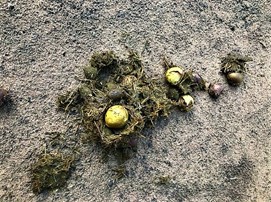February 2022
Marula Magic
Share:
Marula Magic
During the first months of the year, something rather interesting happens here in the bush. A very special tree is bearing fruit and it’s not just any tree, it’s the famous marula tree (Sclerocarya birrea). The genus name Sclerocarya means 'hard nut' and the species name birrea is derived from the word birr, the common name used in Senegal. The tree is called Nkanyi in the local Shangaan language.
On our concession here in the Kruger National Park, we do not have as many marula trees as our lodges do in the Sabi Sands and this is due to the tree's preference for more sandy soils - the dark clay basalt soils dominate here. Fortunately for us, the elephants have been a lot more prevalent than we have been used to in the past marula seasons and if you scan the grasslands from the Lebombo Mountains you will be rewarded with seeing some of the herds of elephants moving from one marula to the next.
The trees each produce hundreds of small green plum-like fruits that fall to the ground where they then ripen to a yellowish color. The fruit is highly nutritious and the taste is tart, sometimes sweet depending on the ripeness and, in my opinion, the tree. These little fruits pack a punch and have roughly eight times the vitamin C content than an orange, and lots of other antioxidants. There is a little edible nut in the center of the kernel and it has lots of protein and high levels of vitamin E.
On our concession here in the Kruger National Park, we do not have as many marula trees as our lodges do in the Sabi Sands and this is due to the tree's preference for more sandy soils - the dark clay basalt soils dominate here. Fortunately for us, the elephants have been a lot more prevalent than we have been used to in the past marula seasons and if you scan the grasslands from the Lebombo Mountains you will be rewarded with seeing some of the herds of elephants moving from one marula to the next.
The trees each produce hundreds of small green plum-like fruits that fall to the ground where they then ripen to a yellowish color. The fruit is highly nutritious and the taste is tart, sometimes sweet depending on the ripeness and, in my opinion, the tree. These little fruits pack a punch and have roughly eight times the vitamin C content than an orange, and lots of other antioxidants. There is a little edible nut in the center of the kernel and it has lots of protein and high levels of vitamin E.
The marula tree grows up to a sturdy 18 m (59 feet) tall and has a distinctive grey mottled bark with wide-spread branches.
The trees and the elephants have co-evolved with the elephants feeding on all parts of the tree from the roots to the leaves, but they also perform a vital function where they facilitate the germination of many of the seeds that they have eaten. So they certainly do cause damage to some trees but they help others to grow. The seeds go through a process of scarification, which is when the seed passes through the relatively poor elephant digestive system which then alters the coat of the seed and encourages germination, and this is then further facilitated by the fact that the seed is deposited in a smelly pile of compost!

The trees have many uses with a homemade jam preserve being one. But a favorite must be the cider or beer that the local Shangaan people so dearly love to make during these hot summer months. The fruit is collected and mixed with water then allowed to ferment for a few days. It is then transformed into a delicious, healthy, and rather refreshing alcoholic drink. The commercial liquor Amarula is made from the same fruits.
The relationship between the tree and alcohol does not end there. The “drunken elephant myth” is something that most guests believe to be true. However, science does not agree with this. Studies prove that elephants don’t usually eat the fermenting fruits - they seem to have more of a fondness for the ripe ones.
The relationship between the tree and alcohol does not end there. The “drunken elephant myth” is something that most guests believe to be true. However, science does not agree with this. Studies prove that elephants don’t usually eat the fermenting fruits - they seem to have more of a fondness for the ripe ones.
The fruits take no more than two days to pass through the elephant’s digestive tract which would not be long enough for internal fermentation to take place. The studies show that they would also need to eat over 1 400 fermented fruits for enough alcohol to be produced for the elephant to feel any effects. All this being said, they do seem to show lots of excitement when savoring these little fruits and so the story of the intoxicated elephant will long remain in African folklore, and aptly so!

By Garry Bruce
Head Guide Singita Kruger National Park